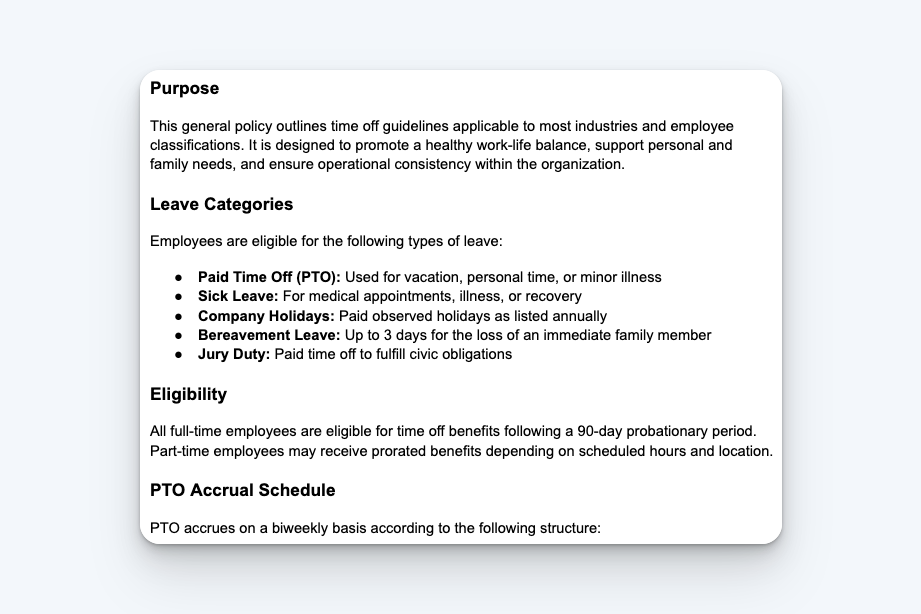How to Create a Time Off Policy + 7 Free Templates
Learn what a time off policy is, why it matters, and what to include. Plus, get access to 7 free templates you can use to get started.

Time off policies help businesses balance employee wellness with operational efficiency. In this guide, we’ll walk through what a time off policy is, why it matters, and what to include, as well as provide a few templates you can use to build your own.
Take a permanent vacation from managing time off with Buddy Punch. Our time off tracking software automatically calculates PTO accruals for you, lets employees see their time off balances and submit PTO requests, and automates things like blackout restrictions, time off approvals, and attendance tracking.

What is a time off policy?
A time off policy is a document that outlines the rules and procedures employees should follow when requesting and taking time off of work. This may include vacation days, sick leave, personal time, holidays, parental leave, and other types of leave.
A clear policy helps ensure fair access while keeping business operations running smoothly.
Why a time off policy can be beneficial for your business
A well-crafted time off policy provides structure and clarity for both employers and employees. Here are a few key reasons to implement one:
- Compliance with laws: Helps you stay aligned with labor laws, such as FMLA, state-mandated sick leave, and local regulations.
- Boosts morale and retention: Employees are more likely to stay engaged and satisfied when they have fair, transparent access to time off.
- Reduces scheduling conflicts: A structured process prevents last-minute absences and ensures coverage during busy times.
- Encourages healthy work-life balance: Demonstrates your company’s commitment to employee well-being.
What to include in your time off policy

Whether you’re creating a one-pager or a more detailed handbook, here are the essential elements to include in your company’s time off policy.
1. Purpose
State why the policy exists. Emphasize the intent to promote well-being, ensure fairness, and maintain productivity.
2. Types of time off covered
Outline which types of leave your policy covers. Some examples may include:
- Vacation
- Sick leave
- Personal time
- Holidays
- Bereavement
- Jury duty
- Parental/maternity/paternity leave
- Volunteer or mental health days
3. Eligibility
Clarify which employees qualify based on employment status (e.g., full-time, part-time, contract) and tenure.
4. Accrual vs. allotment
Explain how time off is awarded:
- Accrual: Earned over time (e.g., per pay period or month)
- Allotment: Granted in full at the start of the year or after a probationary period
- Unlimited PTO: Outline expectations and approval requirements if you use this model
5. Request process
Describe how to request time off, including:
- How much notice is required
- How to submit a request (e.g., app, form, manager email)
- Who approves time off
- Blackout dates or busy periods when time off may be limited
6. Approval guidelines
Explain how overlapping requests are handled (e.g., first come, business needs) and any priority rules (like seniority or rotating schedules).
7. Carryover and expiration
If employees can carry over unused time, include:
- How much can be carried over
- If/when it expires
- Whether unused time is paid out at the end of the year or upon termination
8. Interaction with other leave laws
Include how your policy works regarding time off for special circumstances such as:
- FMLA or state family leave laws
- Mandatory sick leave
- Other protected leaves (e.g., disability)
9. Handling absences and emergencies
Define the process for calling in sick or handling last-minute absences, including who to contact and when.
10. Manager responsibilities
List expectations for managers to:
- Approve or deny requests promptly
- Ensure team coverage
- Model healthy time-off habits
11. Time off abuse
Outline what constitutes abuse of the time off policy and how it will be addressed. Examples include:
- Frequent unscheduled absences
- Patterns (e.g., repeated Mondays or Fridays)
- Misuse of sick leave for non-health-related reasons
Remind employees that misuse of time off may result in disciplinary action, up to and including termination.
12. Termination and final payout
Clarify what happens to unused time off when employment ends:
- Whether unused vacation or PTO is paid out upon termination (as required by company policy or state law)
- Any restrictions (e.g., only accrued and not advanced time is paid out)
- How final balances are calculated and when the payout will be issued
- Whether sick leave is paid out (typically it is not unless required by law)
13. Policy acknowledgment
Ask employees to sign or electronically acknowledge the policy to confirm they’ve read and understood it.
7 free time off policy templates and examples
Time off policies can vary widely depending on your organization’s size, industry, and workforce needs. Below are seven time off policy templates and examples for that you can use to craft a policy that aligns with your team’s structure and values.
| Industry | Template |
|---|---|
| General | View Example |
| Tech/Startup | View Example |
| Consumer Goods/Beverage | View Example |
| Finance/Consulting | View Example |
| Healthcare/Social Assistance | View Example |
| Construction | View Example |
| Church/Non-Profit Organization | View Example |
Please note: This article is for informational purposes only and should not be considered legal advice. Please consult with an expert or employment attorney if you need specific legal guidance on creating a time off policy.


